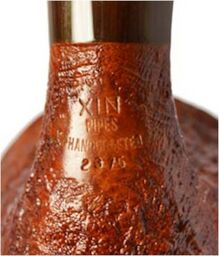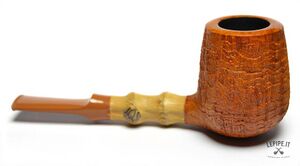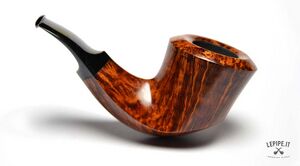Xin Li
Xin Li (b. 1980) is a Chinese artisan pipe-maker currently working under the name Xin Pipes. He is a graduate of the China Academy of Art (Chinese: 中国美术学院) as well as Germany's University of Münster (German: Universität Münster), where he pursued studies in industrial design and art history respectively. Xin is currently based in Hangzhou, in China's eastern Zhejiang province.
Prior to becoming pipe-maker, Xin had a career at a real estate company, but his spare time was occupied by the practical arts. Xin's affinity for woodworking, especially the crafting of furniture, meant that most of his weekends were spent in a small workshop that he owned.
The arrival of Xin's son in 2014 meant that he no longer had much time, nor space for woodworking. By chance, however, he was introduced to the pipe-maker Yang Zhimin by a mutual friend. This meeting was fortutious; Yang was also graduate of the China Academy of Art and the two found that they had much to talk about. Xin's curiosity regarding Yang's craft ultimately led to Yang taking on Xin as his first apprentice.
Beginning in 2015, Xin received hands-on tutelage in pipe-making at Yang's workshop, leaving his real estate career in 2016 to take on pipe-making under Yang full-time. Xin picked up the skills and techniques required for high-grade, artisan pipe-making quite quickly, with Yang soon allowing him to create pipes for Zhiputang. Zhiputang was originally the name used by Yang's own pipe-making, but between 2016 and 2018, Zhiputang pipes became a collaborative project between Xin and Yang. Through this partnership, Xin was able to visit Italy with Yang to learn about and purchase briar from one of its major sources, as well as having the opportunity to sell their Zhiputang pipes through the online artisan pipe marketplace PipeHub.
Xin and Yang dissolved their partnership amicably in 2018, with Xin leaving Zhiputang to found a line of pipes under his own name and with his own particular style. He was able to build a new workshop in the attic of his home, which allowed him to continue his career as a pipe-maker while being able to spend as much time as possible with his young son. Yang and Xin still meet regularly over drinks and pipes.
Xin's Zhiputang pipes show a clear Danish influence, with a recognizable debt to historic figures in this tradition. It should be no surprise that Xin credits Per Hansen and Ulf Noltensmeier of S. Bang among his favorite pipe-makers. While this influence continues to be apparent in Xin's output, the transition from Zhiputang to Xin has more recently resulted in designs that depart from the established Danish mold in a significant way. Xin's background in design and art history has given him an appreciation for a wide variety of movements and schools in the practical arts, though there is a definite minimalist impetus in Xin's approach. In 2024, when asked about his background and how it has affected his pipe-making, he stated,
"I prefer a simpler style, with good proportions and clean lines. Those are the aspects I set out to achieve in my pipe making process. No unnecessary elements or modeling. Always with balanced proportions."
A similar design philosophy can be found in the reflections of Danish icons such as Sixten Ivarsson and Tom Eltang, though this common idea is realized quite differently in Xin pipes, especially those produced in more recent years. On the one hand, Xin currently produces many pipes that lean into the English-French tradition, blending a simplicity of form with a unique and unconventional color palate. On the other hand, Xin also produces pipes that would be better characterized as avant-garde. The latter are still relatively simple, but the few elements that they do bring together result in designs that are nonetheless fresh and out of the ordinary, even in today's artisan scene. There are many pipe-makers whose work Xin has expressed an admiration for. While it would be reductive to try to identify a precedent for each pipe that any pipe-maker creates, one may still discern conventions, communities, and continuities in any craft. Along with Per and Ulf of S. Bang, Xin professes a deep respect for Davide Iafisco, Jeff 'J. Alan' Gracik, Abe Herbaugh, Roman 'Doctor’s' Kovalev, Chris Asteriou, Brighton James, Wandi Riyadi, Li Zesong and, of course, Yang Zhimin.
For example, many of Xin's pipes from the end of 2022 onward gesture at a return to more traditional English-French standards, such as the straight billiard, brandy and pot shapes. The resulting designs will, however, also often feature unconventionally wide, full bowls and short shanks, with much of the briar shank substituted with bamboo. This increase in bowl proportions and decrease in those of the shank and stem has been a common theme in artisan pipe-making from the later 20th century to the present, especially in the Danish and Danish-American schools (J. Alan's pipes being a notable example). This is not without reason, either; not only does it give a distinct look to the pipe, it also reduces its weight and contributes to a more even weight distribution and balance. Xin's employment of bamboo in bent pipes, on the other hand, makes the most of what this material affords that briar ordinarily does not; the introduction of steep curves into the constitutive lines which flow, interrupted, from chamber to slot (here a commonality is to be found between Xin Pipes and, for example, Kovalev's Doctor's Pipes).
Added to these techniques and motifs is a use of color that has, since its inception in the mid 20th century, been quite rare in artisan pipe-making. While artisan pipe-making has, historically, restricted its palettes to blonde, brown, and black stummels and black and red-black stems, Xin's pipes can be found dressed in shades of ocher and mint, brick red and rose, or pecan and khaki. While Xin pipes do not tend to feature vibrant color schemes, preferring more neutral hues, they are nonetheless distinctively colorful.
But there are also pipes made by Xin that eschew tradition in favor of experimentation and the new. As with the pipes of someone like Brighton James, these other Xin pipes evince a desire to produce something out of the ordinary. In Xin's case, a recurring approach appears to be one of warping the basic figures of contemporary artisan staples, introducing unfamiliar angles and inflections; a cobra may be 'pulled' back upon itself in a way that greater resembles its rearing namesake; a brandy bowl may be 'squeezed' at its top to create something more like a cauldron or a pitcher plant. It is as if our ideas as to the many forms a pipe can take can themselves be manipulated like clay in one's hands, periodically provoking the question of at what point a difference in degree becomes a difference in kind.
To date, Xin's pipes have been sold at PipeHub, SATX Pipe, and LePipe.It.
Gallery
Contact Information
Xin Li Email: lixinthepipemaker@gmail.com Instagram: https://www.instagram.com/xinpipes/ WeChat: Xinpipes














